The winner – Drip
Not great not terrible
In this comparison, Drip wins five out of eleven rounds. Three rounds end in a tie, and there are three aspects where tinyEmail outperforms Drip. Continue reading to learn about the cases where Drip outperforms tinyEmail and why.
What Drip features are better than tinyEmail?
- Marketing automation features
- Signup form builder
- Segmentation
- Reports
- Basic marketing automation
- Signup form builder needs improvements
- Quite basic reports
Some email marketing platforms distinguish themselves more prominently than others. Two notable examples are Drip and tinyEmail, established in 2019 and 2021, respectively.
Drip has been widely acknowledged and praised for its extensive and multifaceted features. Likewise, tinyEmail is significantly increasing in popularity because of its AI-centric approach.
Both Drip and tinyEmail share certain commendable strengths, but their unique offerings differentiate them. Therefore, weighing the pros and cons of using tinyEmail or Drip for your email marketing efforts is essential.
In this comprehensive comparison of Drip vs tinyEmail, we’ll discuss various aspects, such as ease of use, pricing structures, distinct features, and the quality of customer support.
Without further ado, let’s get started.
tinyEmail vs Drip: Quick overview
tinyEmail has an impressive rating of 4.7/5 on the Shopify App Store, while Drip boasts a commendable 4.4/5 rating.
tinyEmail uses artificial intelligence to optimize email campaigns and increase engagement and open rates. Drip offers various tools designed to automate, personalize, and measure the impact of email marketing campaigns.
Here’s a quick, feature-by-feature comparison of tinyEmail vs Drip, before getting into the specifics.
The table above sums up the key features offered by tinyEmail and Drip. But, analyzing each feature will provide a comprehensive and detailed perspective.
tinyEmail vs Drip: Feature by feature
tinyEmail and Drip each present a unique set of features. Below, we’ll highlight the notable features that make both platforms stand out. Let’s get started.
Ease of getting started
Drip’s signup process is refreshingly brief. Just provide some basic business details, such as an email address, and you’re good to go—no credit card is required. The same cannot be said for tinyEmail, which presents a series of questions to sign up. You’ll also have to perform vital tasks like:
- Uploading your logo
- Choosing brand colors
- Adding personal data
While thorough, this process may appear demanding to some users.
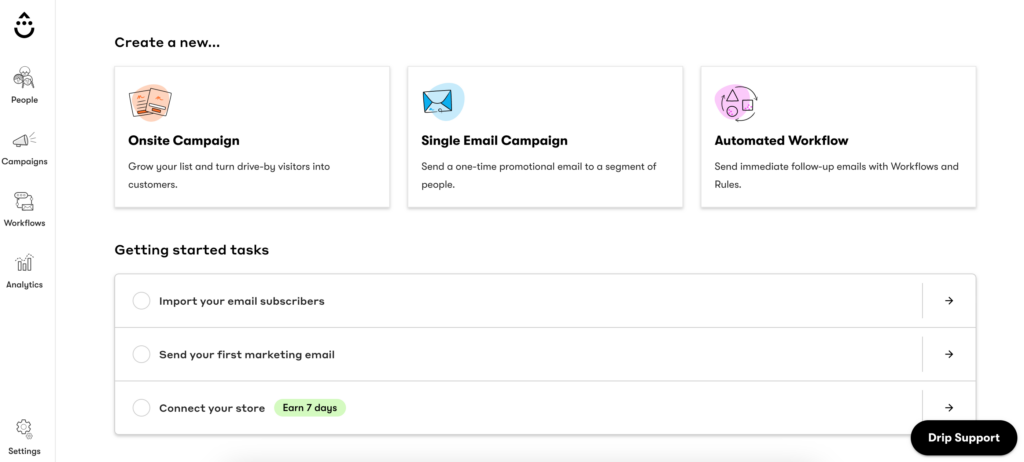
Drip getting started dashboard
Regarding credit card requests during signup, tinyEmail’s approach seems somewhat misleading.
Unlike Drip, tinyEmail demands your credit card information even for the trial. But soon after, you’ll receive an email stating you can sign up without using your credit card. This doesn’t exactly scream trust.
With regards to usability, both Drip and tinyEmail perform excellently. tinyEmail shines with an interface similar to that of tools like Omnisend and Mailerlite. The platform is sleek, modern, and generally intuitive.
Drip is also beginner-friendly. Once signed up, you’re walked through guided tasks, accompanied by helpful video tutorials and documents.
Drip leads slightly in this round. While both platforms offer a solid start, Drip’s transparent, swift, and supportive onboarding gives it an advantage.
Building an email campaign
In tinyEmail, naming a campaign and adding a preheader is a breeze. The platform offers an intuitive email campaign wizard, guiding you step-by-step. On the other hand, Drip takes a more complex path. Setting up foundational tasks feels less intuitive and requires more effort.
tinyEmail outperforms Drip in terms of email design capabilities. It has a handy stock image library if you need visuals and a comprehensive email builder with several customization options. tinyEmail has features that enhance the quality and functionality of your emails, such as:
- Timers
- Image carousels
- AI-generated text
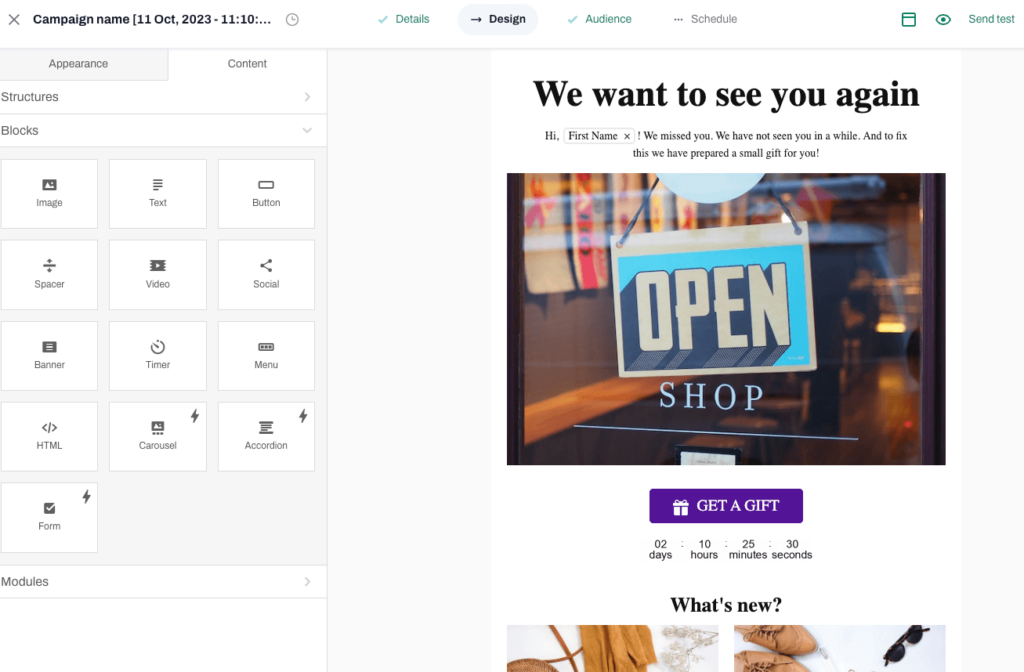
tinyEmail Email builder
Whereas, Drip’s email builder feels constrained. For instance, if you choose a single-column template, that’s what you’re stuck with. Nevertheless, adding images and other content blocks is a straightforward process.
Regarding templates, tinyEmail offers an impressive template selection with over 300 designs to choose from, as against Drip’s limited 52 template options.
Currently, tinyEmail focuses on regular email campaigns, with the prospect of introducing SMS campaigns soon. Sadly, features like A/B testing (which is present in Drip) and RSS campaigns are missing. Drip, on the other hand, offers more variety with standalone emails, email series, and automated workflows.
tinyEmail uses merge tags for personalization but lacks dynamic elements or product recommendations. On the other hand, Drip allows content personalization but has limitations in its subject lines and preheaders.
tinyEmail leads with its robust email builder and template arsenal. But the race is tight, with Drip trailing closely thanks to its email variety.
Marketing automation
Which tool presents the best marketing automation capabilities—tinyEmail or Drip? Let’s find out.
tinyEmail provides a basic, straightforward approach. The available automation workflows are limited if you’re not a Shopify user. Other than the welcome email, there’s no flexibility to modify or tailor the given workflows.
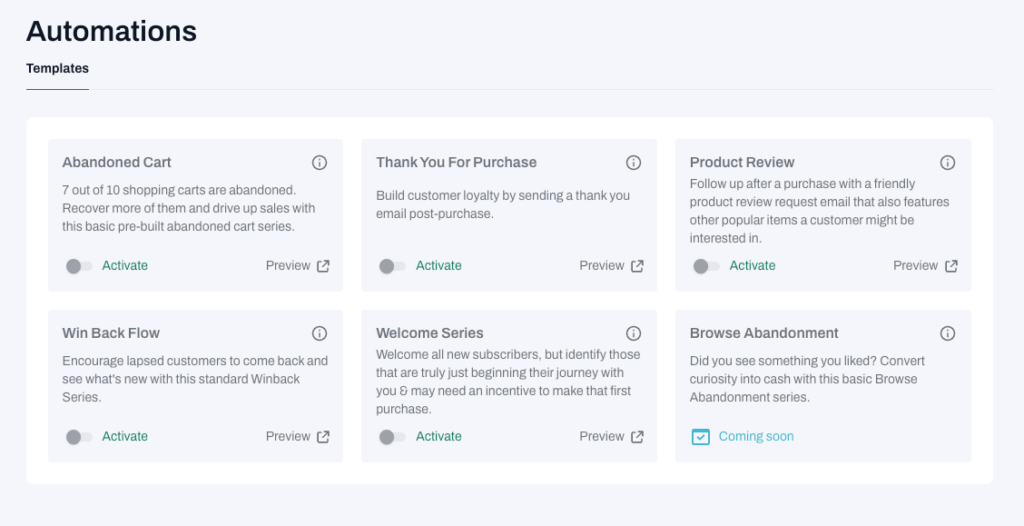
tinyEmail automations
In Drip’s corner, things look more intricate and the interface is more polished. Users can dip into varied actions, map out parallel paths, and even run split tests. It’s a rich experience overall.
For pre-built workflows, tinyEmail serves up several templates, such as:
- Abandoned cart
- Product review
- Thank you message
- Welcome series
However, it’s worth noting that the automation options mentioned above work only with Shopify.
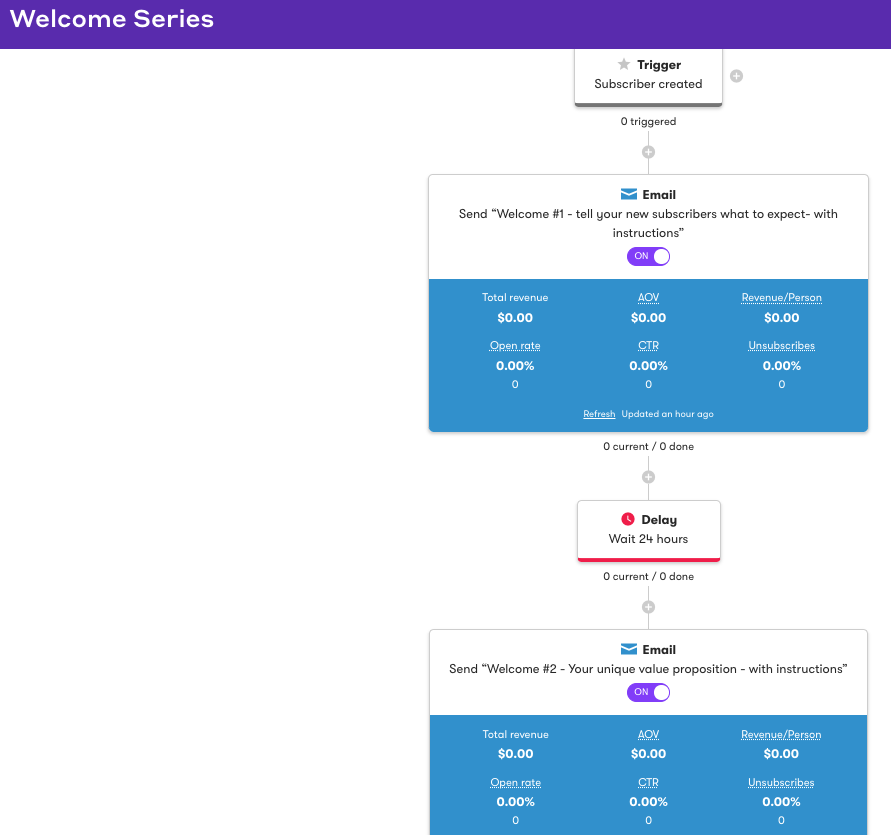
Drip automations
Drip offers 40 pre-built templates that cater to diverse use cases and platforms. However, Drip only provides the template structures and not the content or email design.
Unlike Omnisend or Klaviyo, Drip and tinyEmail don’t offer omnichannel workflow integration.
Drip takes the lead in this round. Its rich features and diverse templates overshadow tinyEmail’s basic offerings.
Signup forms and landing pages
tinyEmail offers a wide of signup form templates, including:
- Embedded forms
- Popups
- Flyouts
While they sport a modern design, customization seems to be a hurdle. For instance, adjusting or changing the default image can be tricky due to its limited editing options.
On the other hand, Drip presents users with over 30 sleek signup forms. These forms are visually appealing and designed for various purposes, such as gathering the email addresses of prospects or guiding them to a landing page.
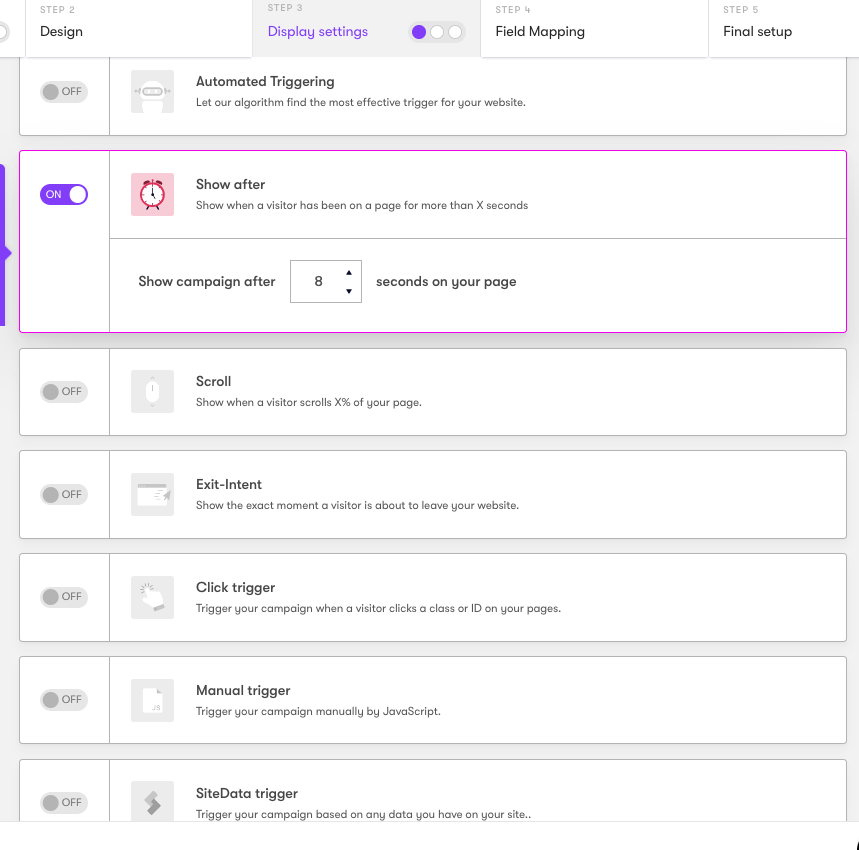
Drip popup settings
Furthermore, adapting these forms to align with your brand colors is straightforward with Drip.
Drip offers users an array of options for displaying forms. You can choose from:
- Automated triggering (AI generated)
- Show after X seconds
- Show after X% scroll
- Exit-intent
- Click trigger
- Manual trigger
- SiteData trigger
Unfortunately, tinyEmail lacks this flexibility. Forms have to be manually embedded into the website, which can be quite inconvenient. Yet, neither provides landing pages.
Analytics is another area where differences exist between Drip vs tinyEmail. Drip offers the following insights on its forms:
- Views
- Submissions
- Conversion rates
On the flip side, tinyEmail doesn’t provide users with performance analytics.
tinyEmail makes list management easy as it offers insights into subscriber sources. However, the depth of these insights could use some enhancement.
Importing customer databases on Drip is seamless. Whether it’s through importing a .csv list, copying and pasting, or migrating from other platforms like Mailchimp, Drip has it covered. Moreover, Drip’s tagging mechanism facilitates easy segmentation of customers.
Drip wins this round. Its advanced form designs, performance analytics, and easy list management give it an edge over tinyEmail.
Segmentation
Both tinyEmail and Drip offer segmentation features but with varied depth and accessibility.
tinyEmail provides 15 pre-defined segments, but there’s a catch. Only 4 of these segments are available for Standard plan users. The remaining 11 are reserved for Pro plan subscribers.
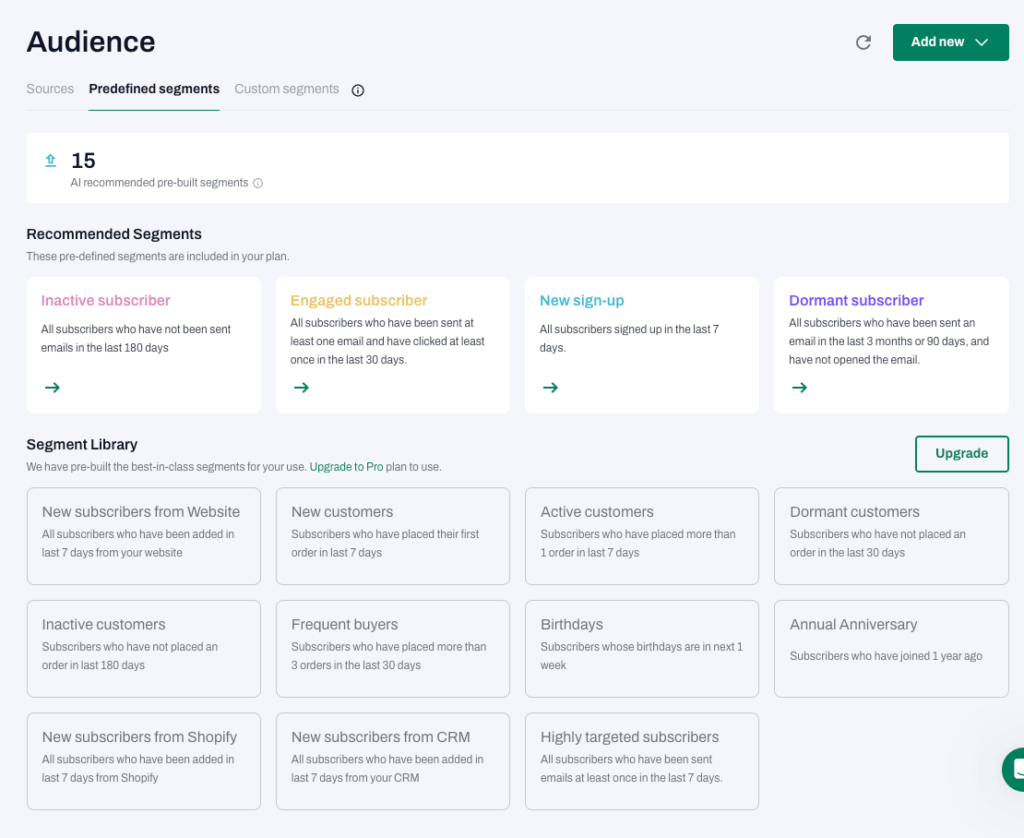
tinyEmail segments
Drip, on the other hand, offers a modest number of basic segments. It also appears that the majority of the segmentation process is left to the user.
In terms of robustness, tinyEmail leans towards the basic side. Users can segment based on email activities, like receiving or opening an email. Additionally, subscriber details, such as location and order count, play a role.
Meanwhile, Drip is on the robust end of the spectrum and its list of segmentation options is extensive. Users can segment based on the following criteria:
- Email activity
- Orders and products
- Review activity
- Loyalty programs
- Segments and workflows
- Onsite forms
- Events performed
- Person tags and fields
Both tinyEmail and Drip have their downsides when it comes to segmentation.
For tinyEmail, segmentation is limited to paid subscribers. It also misses out on ecommerce conditions, onsite behavior, and tag-based segments. Drip, while rich in features, would benefit from additional ready-to-use segments.
Drip takes the lead. With its diverse segmentation options, it offers more depth compared to the basic offerings of tinyEmail.
Analytics
When analyzing email performance, which platform offers greater clarity—tinyEmail or Drip? Let’s find out.
tinyEmail’s analytics focus on the basic elements. It provides insight into email activity, encompassing open, click, and delivery rates. You can also see the trend in email campaign performance.
For Shopify users, a workaround allows them to track sales resulting from email campaigns. You can also see a list showcasing each email link and the clicks it’s garnered.
On the other hand, Drip offers a more comprehensive approach to analytics. It provides users with details on:
- Email campaign engagement
- Total revenue and average order value
- Metrics like unsubscribes and clicks by link
- Recent activity metrics
- Site traffic
- Conversions
However, no tool is without room for improvement. tinyEmail could benefit from incorporating:
- Geolocation reports
- Ecommerce insights, such as orders and revenue
- Real-time analytics
- Signup form analytics
Despite Drip’s advanced analytics, it could still enrich its data with deeper ecommerce-centric insights.
Drip emerges as the winner because it focuses on a broader range of metrics, from email engagement to revenue insights.
Customer support
tinyEmail extends support 24/7 via email and chat.
Additionally, tinyEmail’s onboarding call exemplifies its intent to ease users into the platform. Its self-help online resources are of immense value, although they may not be as extensive as some competitors’ offerings.
Drip tailors its support to paying customers by providing:
- Email support from 9 a.m. to 5 p.m. CT, Monday to Friday.
- Live chat support for users on the $99/mo+ plans during the same hours.
A standout feature is the live platform walkthrough sessions held every Tuesday and Thursday. The sessions guide users who need help figuring out where to begin.
Every platform has drawbacks, and tinyEmail needs to catch up with the absence of weekend and phone support.
Drip, on the other hand, falls short because it lacks support for free trial users, weekend support, and phone support.
Both platforms provide responsive support, but tinyEmail offers round o’clock support which is important.
Integrations
tinyEmail demonstrates its versatility by supporting migrations from notable platforms, such as:
- Mailchimp
- Campaign Monitor
- Drip
- Constant Contact
- Klaviyo
- Mailerlite
This feature is especially valuable for users looking to transition from another platform without hassle.
It also offers key ecommerce integrations with ecommerce giants like Shopify, WooCommerce, Magento, and Volusion. For ecommerce businesses, this guarantees seamless alignment of sales and email marketing efforts.
Other integrations it offers include:
- Pabbly connector
- Integrations with CRM platforms like Quickbooks, Zoho CRM, HubSpot, and Salesforce.
- Payment gateways like Stripe and PayPal
- Forms integration with Optinmonster
Drip, on the other hand, showcases its strength through:
- Native integrations with leading ecommerce platforms like Shopify, Bigcommerce, and WooCommerce.
- An expansive list of both native and Zapier integrations to enable businesses to find the tools they need.
Again, it’s a tie. Both platforms provide a decent list of integrations and help to migrate from one tool to another.
Compatibility with other marketing channels
In this section of our tinyEmail vs. Drip comparison, we’ll analyze how many marketing channels each tool is compatible with.
tinyEmail primarily centers on email marketing, establishing itself as a specialized tool. While the platform would likely move to include SMS in the near future, it’s still in the pipeline.
On the flip side, Drip doesn’t directly support multiple marketing channels within its drip campaigns. Its strength lies in allowing users to utilize integrations with external tools. This offers an avenue to indirectly connect with various marketing channels.
This round ends in a tie. While tinyEmail hints at future expansion with its upcoming SMS feature, Drip leans on integrations with third-party tools.
Generative AI tools
The integration of AI in email marketing is a forward-thinking move. Such AI tools can offer tailored content, design suggestions, and effective subject lines. Let’s examine the AI offerings of tinyEmail and Drip.
tinyEmail has introduced TinyAlbert. This new tool is exclusively for Shopify businesses. It uses GPT-4 AI to manage email marketing tasks, including:
- Generating content
- Designing emails
- Other campaign optimizations
In contrast, Drip doesn’t offer any AI-driven tools. While it provides various features and integrations, the lack of AI capabilities might be a key limitation.
tinyEmail is the clear winner. Its use of GPT-4 AI through TinyAlbert provides a distinct advantage. Drip, lacking in this area, may not meet the needs of users looking for advanced AI solutions in email marketing.
Price comparison
Choosing the right email marketing platform often hinges on its cost-effectiveness. Understanding their pricing structure becomes paramount, given the range of features and tools these platforms offer.
Here, we delve into the pricing details of Drip vs tinyEmail to discern which platform offers better value for money.
Free plans comparison
tinyEmail offers a free plan catering to budding businesses or individual users. Under this plan, users can enjoy benefits such as:
- Service for up to 500 subscribers
- A quota of 15,000 emails per month
- Access to forms and popups
- Automation emails
- An AI-driven subject line assistant
- Limited sender identities
In addition, tinyEmail offers Shopify Pro plan for Shopify users which includes multiple paid features free of charge.
Drip, on the other hand, doesn’t offer a permanent free plan. It provides a 14-day trial, giving potential users a glimpse into its offerings. Here’s what you get with the free trial:
- Limited emails
- Users can access features like automated workflows based on customer activity
- Access to over 90 integrations, including connections to Shopify, BigCommerce, and WooCommerce
- Access to email templates and a visual builder.
In regard to the free plan offering, tinyEmail is much more generous compared to Drip.
Paid plans comparison
Which platform offers the most flexible paid plans—Drip or tinyEmail?
Well, let’s compare the paid plans of both tools to help you gauge which platform best aligns with your budget and business goals.
The table below offers a brief comparison of the paid plans from tinyEmail and Drip:
Drawing insights from the table, tinyEmail provides users with tiered plans, with pricing based on the number of email sends. This structure might be particularly attractive to businesses where email sends vary but the subscriber base remains constant.
Note that tinyEmail offers an Enterprise plan, its highest pricing tier. This plan is tailored for large organizations seeking custom email marketing features.
Conversely, Drip takes a straightforward approach. It has eliminated tiered plans in favor of a singular pricing model that revolves around the contact list size. Drip unlocks all its features to the paid customers regardless of the monthly subscription. However, Drip is more expensive than tinyEmail.
Related picks for you
tinyEmail vs Drip: Which one wins?
Before declaring a victor, it’s imperative to reflect on the features and pricing structures of tinyEmail and Drip:
3.5
3.8
Up to 15,000 emails – $15
Up to 25,000 emails – $25
Up to 50,000 emails – $50
Up to 100,000 emails – $100
Up to 250,000 emails – $250
Up to 500,000 emails – $500
Up to 1,000 subscribers – $39
Up to 5,000 subscribers – $89
Up to 10,000 subscribers – $154
Up to 25,000 subscribers – $369
Up to 50,000 subscribers – $699
Up to 100,000 subscribers – $1199
– Up to 500 subscribers
– Up to 15,000 emails
– Forms and popups
– Automation emails
– AI subject line assistant
– Limited sender identities
– Shopify Pro pricing plan for Shopify users
– 14-days trial of all features
– Email campaign to up to 500 recipients
– Easy to signup and use
– Good email builder
– An extended list of email templates
– Very good marketing automation functionality
– Very good segmentation
– Easy to get started
– Basic automation
– Basic reporting
– Basic segmentation
– Form builder should be improved
– More expensive than other tools
– Limited email builder
– No landing pages
– Limited customer support
– Small ecommerce businesses
– Email marketing beginners
– Bloggers
– Non-profit organizations
– Ecommerce with established marketing budget
– Established ecommerce businesses
– Freelancers
– Non-profit
– Small businesses
tinyEmail’s innovative AI tool is ideal for Shopify businesses. The pricing model emphasizes email sends more than subscribers, thereby providing flexibility for businesses with varying email frequencies.
Whereas Drip presents a straightforward pricing approach depending on the contact list size. Every user can enjoy the tool’s full capabilities regardless of their list size, thereby eliminating tiered access to features.
In summary, while both platforms present compelling advantages, the optimal choice hinges on your specific needs and business model.
Read full reviews
Related picks for you
Our team strives to be accurate and unbiased in reviewing email tools. However, we recognize that mistakes can happen, and it’s essential for us to stay up to date. If you come across any errors or things that need to be reviewed again, please let us know.





Leave a Reply